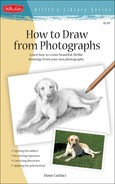0%
27Chapters
0-1Hours read
0kTotal Words
Book Description
Photographs are valuable reference tools that most artists use. Complex subjects are generally easier to draw from photos-plus other factors, such as weather, movement, and lighting, can make drawing from life nearly impossible.
Table of Contents
- Cover
- Title Page
- Contents
- Introduction
- Tools and Materials
- Camera Equipment
- Taking the Photo
- Fixing Distortion
- Understanding Lighting
- Approaching the Drawing
- Composition Basics
- Drawing Techniques
- Developing Style
- Staging a Composition
- Contrasting Values for Effect
- Showcasing Light Subjects
- Using a Grid as a Guide
- Working from Nature
- Creating a Softer Feel
- Tricking the Eye
- Understanding the Subject’s Context
- Applying Linear Perspective
- Achieving Depth
- Selecting the Best Format
- Bringing It All Together
- A Note of Encouragement
- Copyright Page
